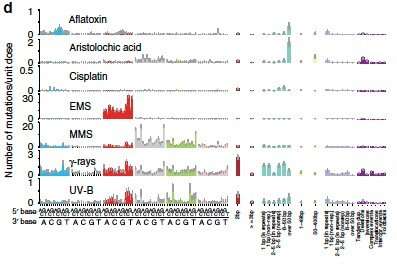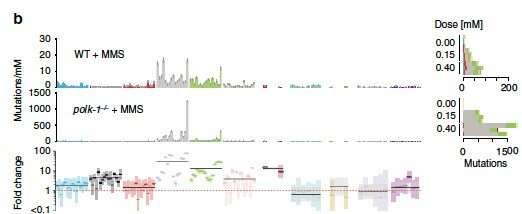First systematic report on the tug-of-war between DNA damage and repair

A collaborative project between the Center for Genome Integrity, within the Institute for Basic Science (IBS, South Korea), and the Dundee School of Life Sciences, the EMBL's European Bioinformatics Institute (EMBL-EBI), and the Wellcome Sanger Institute (UK) have screened almost 163,000 DNA mutations in 2,700 C. elegans roundworms to shed light on DNA damage. The results, published in Nature Communications, lead to the conclusion that mutation patterns seen in cancer are more complicated than we previously thought.
Our genetic material is constantly exposed to possible sources of mutations, including UV light, tobacco smoke and carcinogenic chemicals. These genetic alterations are usually corrected by an army of DNA repair proteins that patrol the DNA and fix its mistakes. However, what happens when the policemen themselves are malfunctioning? They can overlook some DNA alterations, or even generate some mutations while trying to correct them. In this study, researchers looked at mutational signatures—patterns of mutations occurring in the genome—caused by the combined action of 11 known DNA damaging agents and inaccurate DNA repair mechanisms using C. elegans worms as a model system.
"Our paper is the first to use experimental approaches to systematically test, at a genome-wide scale, how DNA damaging agents cause mutations, and how this is prevented by DNA repair proteins," says Anton Gartner, Associate Director of the IBS Center for Genomic Integrity and co-leading author of this study.
While mutagens were thought to generate unique mutational signatures, the results showed a more intricate picture. DNA repair pathways are highly redundant: up to four different repair pathways act together to prevent mutagenesis caused by the same cancer inducing agents. Using roundworms with 53 different DNA repair deficits, the researchers found out that a single mutagen may leave a variety of mutational signatures depending on the faulty repair system.
-

Exposure to various mutagenic agents causes distinct mutational profiles. Credit: IBS -

Example of base substitutions caused by the mutagen MMS (methyl-methan sulfonate) differ between WT (upper panel) and polk DNA repair defective strains (lower panel), T>A changes (indicted in gray) being increased >30 times. Credit: IBS
This study is particularly important because unmended mutations in specific parts of the DNA can lead to cancer. Since fundamental processes, such as DNA repair, are conserved throughout evolution, the team was able to use data derived from C. elegans to scan through thousands of human cancer genome sequences and find possible evidence for mutagenic events linked to faulty DNA repair systems.
Over the past years, mutational signatures of cancer have been deduced from computational analyses. Some of these signatures could be associated with suspected mutagenic causes, such as the exposure to UV light for melanomas, or exposure to aflatoxin for liver cancer. However, the cause of the majority of these mutational signatures observed in cancer is not known. In most cases, it is unclear if there is a direct one-to-one relationship between the mutational signatures and a single mutagen. This paper reports that mutational signatures are due to a combination of factors, 'offending' DNA damaging agents and cellular policemen that properly do their job most of the time, but in some cases allow culprits to escape.
More information: Nadezda V. Volkova et al, Mutational signatures are jointly shaped by DNA damage and repair, Nature Communications (2020). DOI: 10.1038/s41467-020-15912-7
Journal information: Nature Communications
Provided by Institute for Basic Science

















